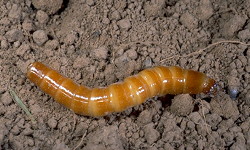Wireworm Control Needed in Some Kentucky Fields
Wireworm Control Needed in Some Kentucky Fields

Wireworms plague many central Kentucky cornfields causing an uneven stand and skips in the field where seeds and plants have been killed.
“We’ve been having increasing problems with wireworms for the past four or five years,” said Ric Bessin, University of Kentucky College of Agriculture entomologist. “We’re not sure if this is just a long-term cycle or if it is one that will be around for awhile. We are trying to come up with a way to manage wireworms as economically and effectively as possible.”
For the past three years, Bessin has been researching the best options for farmers to prevent having wireworms damage their crops. Wireworms, the larvae of certain beetle species, live in the soil and feed on germinating seeds and young seedlings. In some cases, stand loss can exceed 50 percent.
“Once you start to see you have a problem in the field there’s really nothing you can do about it with that stand of corn,” he said. “Your only choice is whether or not to replant, and it actually takes a pretty substantial yield loss to warrant replanting. It’s on the order of a third of a stand lost before it’s economical.”
When managing for wireworms, using preventative controls at planting are the only real resolutions. Control options include seed treatments, granular insecticides and liquid insecticides applied to the soil at planting.
“We have some pretty good tools,” Bessin said. “One thing to keep in mind is that wireworms have a long life cycle (multiple years) so you could be fighting the same ones year after year. So if you had a problem with wireworms in 2006, that’s a real indication that you need to watch that field in 2007. History is very important when it comes to wireworms.
These pests can cause extreme stand loss and stunting. If a corn grower suspects there’s a problem, they need to sample those fields and dig up some seed kernels. If they have small holes in them or at base of a seedling, that’s excellent evidence of wireworm damage.
Wireworms problems used to seen primarily when sod fields were first planted with corn. Today, though, the problems are being found more in no-till fields in corn-soybean rotation.
Also, people are trying to get corn into ground earlier in the spring because they are planting more acres and because of concern about moisture later in the growing season.
“People need to think about wireworm management and some of these early planting dates,” he said. “Make sure the soil temperature warrants planting so we can get the seedlings up out of the ground quickly. Where you have faster germination and seedling growth, you have less opportunity for wireworm attack. Seeding problem fields early is a recipe for disaster with wireworms.”
Seedling vigor is important. Farmers need to use varieties with good seedling vigor in problem fields. Field history is very important.
Evaluating risk is difficult, Bessin said. UK recommends using bait traps which are basically eight-by-eight-by-eight holes dug into the field with wheat-corn mixture placed in them and covered with black plastic a couple of weeks before planting. The worms don’t move much in the soil, so a grower should have at least 10 holes per field. A few days before planting check to see if there are any wireworms in the trap. If one worm is found per hole, some type of control measure is needed.
“My expectation is with some fields in this area you are going to have a whole lot more than one worm per hole,” he said. “You may see 10 to 15 or more in some of these high pressure fields.
“One problem as people try to plant earlier and earlier each year, there is less time to put out these traps and let them warm up enough for the wireworms to get in there,” he said.
